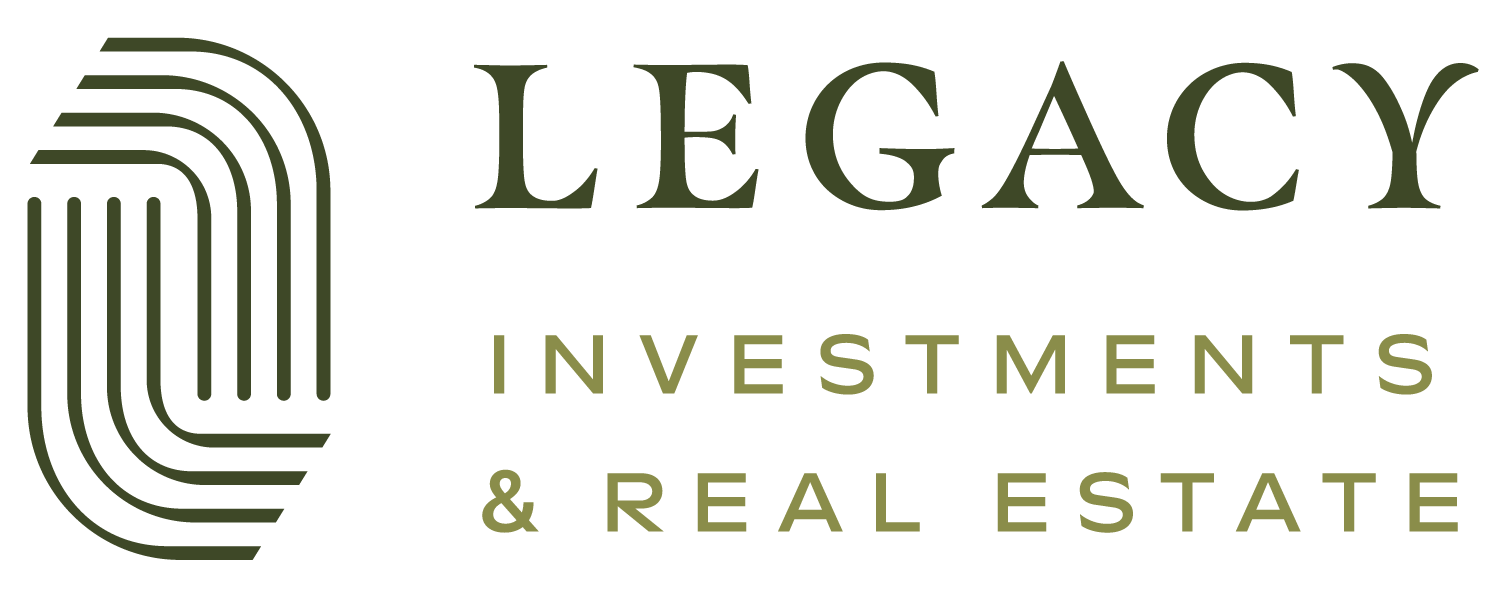
Frequently Asked Questions
General Questions
-
An investor may need to meet the definition of an “Accredited Investor” under the Securities and Exchange Act of 1933 Rule 506 Regulation D (Reg D) if they are considering investing in a Private Placement (PP). Accredited investors are investors who satisfy Security and Exchange Commission requirements for net worth, asset size, income, professional experience or governance. To be recognized as an “Accredited Investor” Under Reg D, the investor must have net worth greater than $1 million, either individually or jointly with the investor’s spouse, excluding the primary residence. OR, $200,000 income individually / $300,000 jointly for the last three years. A Legacy team member can assist you in determining if you meet this definition.
-
Capital gains are the profits (or losses) earned from the sale of a real estate asset. Capital gains and losses are classified as long term if the asset was held for more than one year, and short term if held for a year or less. Short-term capital gains are taxed as ordinary income at rates up to 37 percent; long-term gains are taxed at lower rates, up to 20 percent. A 1031 exchange may help an investor defer 100% of the taxes, including capital gains taxes, that would typically be owed on the sale of an appreciated real estate asset.
-
Knowing your “Cost basis” is essential when doing a 1031 exchange analysis. In United States tax law, cost basis is the original cost of property plus the cost of improvements, adjusted for factors such as depreciation. The IRS defines basis in IRS Publication 551 as “the amount of your investment in property for tax purposes. Use the basis of property to figure depreciation, amortization, depletion, and casualty losses. Also use it to figure gain or loss on the sale or other disposition of property.” Your CPA or tax preparer can help you determine your cost basis.
-
Like-kind properties are real estate assets that can be exchanged without incurring a tax liability, as specified in Section 1031 of the Internal Revenue Code (IRC). In a 1031 Exchange, your replacement property must be “like-kind” to your relinquished property. But like-kind doesn’t mean exact-kind. You don’t have to trade a farm for a farm, or an apartment complex for an apartment complex. You can exchange any business or investment real estate for any other piece of commercial real estate. Generally, if the purpose of the taxpayer is to hold the property as an investment for use in a trade or business, real property will be like-kind with other real property.
-
The 45-day identification period is the amount of time allotted for the exchanger to identify replacement property for their exchange. This 45-day period begins on the day one closes escrow on the relinquished property and ends at midnight on the 45th day following the close of escrow. Generally, no extensions are granted for deadlines that fall on weekends or holidays. Your qualified intermediary will notify you of your 45-day deadline in writing. Once the 45-day identification period passes, you cannot add more properties to your list of target properties.
-
A 1031 Exchange investor has 180 days to close on (or acquire) their replacement property. This period includes the 45 days used to identify the replacement property and ends either 180 days after the close of escrow date of the relinquished property or on the due date of the federal income tax return for the year in which the Exchanger relinquished the property in the exchange. A lot needs to happen quickly once your exchange timeline begins. You have to identify replacement property(ies), conduct due diligence, qualify for a loan if needed, and negotiate a purchase. If you don’t watch out, failing to complete these tasks on time could force you into an unsuitable investment, or disqualify your exchange entirely.
-
A qualified intermediary (QI) is a third-party entity that serves to facilitate the 1031 Exchange on behalf of the exchanger. The QI works under an agreement with the exchanger to take possession of proceeds from the escrow of the relinquished property and utilize them to fund the escrow of the replacement property, which may include DST purchases. Utilizing a QI during the 1031 Exchange process prevents the exchanger from having “constructive receipt” of the funds from the sale of the relinquished property. If the sales proceeds from the relinquished property are sent to your bank account, inadvertently or not, you will have a failed exchange. Legacy does not perform intermediary services, but we can refer you to one of the trusted professionals we work with who are experienced and bonded. We recommend you contact a Qualified Intermediary once you have an offer on your relinquished property.
-
A Real Estate Investment Trust (REIT) is a corporation that invests in real estate through properties or mortgages. REITs typically raise capital to purchase a portfolio of properties over a period of several years to produce a rental income. REITs can be offered as private placement investments to accredited investors or publicly traded. REITs provide an alternative to individual ownership of real estate via fractional ownership in institutional quality real estate. Most large estates, family trusts, endowments, foreign investors, pension funds, life insurance companies, and individual high-net-worth investors participate in fractional ownership through one of the following legal entities: REITs, DSTs, TICs, LLCs and/or Limited Partnership. REITS do not qualify as “like kind” for the purposes of a 1031 exchange and therefore are not recognized as a 1031-exchange eligible investment option.
DST Questions
-
DSTs are formed by a third party, called the sponsor, who creates the DST by acquiring a property or properties and putting them into the trust. Sponsors then open the trust so investors can purchase a beneficial interest. Sponsors are professional real estate and management companies whose business is to acquire and manage investment real estate that would not be available to smaller investors.
As a beneficiary of the trust, you would have no say in the day-to-day management of the property or the eventual sale of the property – these activities are handled by the Sponsor. However, the sponsor of the DST will outline the strategy and timeline for disposition of the property in the private placement memorandum (PPM). Some DST sponsors manage properties on behalf of the DST while other sponsors hire professional management and oversee the management company. The goal is to improve the operation of the property to increase income and long-term value, although there is no guarantee that will happen.
Because the sponsor manages and operates the property – including overseeing the leasing of units as well as for paying all property expenses and making the majority of repairs and renovations that may be required at the property – investors in the property enjoy the benefits of their investment with no management headaches, no out of pocket expenses, and no capital calls. Because of our high standards, we do not work with every sponsor who offers DSTs, and instead work only with those who have earned our confidence.
-
Similar to REITs, DSTs are pooled real estate investments that allow for fractional ownership. The benefits of both DSTs and REITs are that with smaller investment amounts, individuals have access to institutional-quality real estate and can create a portfolio of real estate investments and benefit from diversification. The most significant difference between REITs and DSTs is that REITs are not recognized by the IRS as “like-kind” for the purposes of a 1031 exchange, while DST interests are (per Rev Ruling 2004-84). A 721 exchange, or UPREIT, is an alternative to a 1031 exchange that allows an investor to defer capital gains taxes on the disposition of a property while acquiring shares in a REIT.
-
While DST interests are transferable, there currently is no secondary market for these shares. Both Legacy Investment Real Estate and the program sponsor may assist you in finding a buyer for your shares, but we generally consider DST investments illiquid and suggest you remain invested until the program goes full cycle. If you think you will need liquidity prior to the end of the investment term, you might consider doing a partial exchange and keep some cash in a more accessible vehicle.
-
There are no out of pocket expenses for DST investments. The reason you have no out of pocket expenses in DSTs is because all of the expenses associated with the DST investment are conveniently built into the fund. Some of these expenses are represented as a front-end load. To see these costs, take a look at the “Estimate Use of Proceeds” section within a PPM. Every DST will have its own use of proceeds, and there are norms within the industry that we monitor closely. Fees represent the cost to acquire, meet all SEC guidelines, and market the DST. Projected returns are calculated on your full equity investment. For example, if you invest $100k into a DST, a projected 5% cash on cash return is calculated on $100k.
-
The decision to sell the DST is determined by the Sponsor, based on market conditions and other variables. The average holding period historically is 5-7 years. You will be notified prior to the sale of the asset, at which point you will be eligible to conduct another 1031 exchange pursuant to current tax law and can exchange into any “like-kind” property including but not limited to another/more DST properties. Investors in a Delaware Statutory Trust can exchange indefinitely pursuant to current tax code and laws.
-
Due to the passive nature of DSTs, sponsors typically select properties with lower risk profiles. While these properties may provide the benefit of more consistent cash flow, they generally also produce lower yields. Investors who have previously operated their own properties may be accustomed to higher yields, though these returns may have been partially produced by self-management versus hiring a third party or from owning riskier investments. Investors in DSTs generally accept a lower total return in exchange for a passive investment, the anticipation of more consistent cash flow, tax benefits, and potential appreciation — and no headaches. There may be DSTs available in the marketplace with higher potential yields, and it’s important to assess any risk associated with a higher potential cash flow.
-
Each year, the DST sponsor company will send you a complete tax package for reporting your investment on your tax return. K-1s are NOT issued as these are not partnership investments. Annual tax reports may be in the form of a 1099, profit and loss statement, grantor letter, etc. The annual income and any eligible deductions will be reported by your tax preparer on your Schedule E. Tax benefits that you may receive include depreciation, expense deductions, and the potential for appreciation, just like with fee simple real estate ownership. Because all bookkeeping and reporting is handled by the DST, you are not required to keep any of your own receipts. You may be required to file a return in the states where the DST property(s) is located.
-
You are purchasing an Interest in the Trust, which owns the Properties. For federal income tax purposes, an Interest should constitute an interest in replacement property and you will be treated as having assumed your pro rata share of the Trust’s debt for purposes of calculating the amount of your replacement property for purposes of Section 1031. If properly structured, the DST will be classified as a grantor trust for federal income purposes and, as a result, the purchaser of a beneficial interest in the trust will acquire an undivided interest in the assets(s) held by the DST. With a Delaware Statutory Trust, the investors are the beneficiaries, and the sponsor is the grantor. The DST holds the title to the properties in the trust.
-
Typically, there is a range of Loan to Value (LTV) available within the DST inventory. Many Investors’ Relinquished Properties are encumbered by debt. To avoid “mortgage boot”, the debt placed or assumed on your new property must be equal to or greater than the debt you pay off using your sale proceeds. Any debt or equity not replaced is considered boot; you’ll owe taxes on that money. You can offset debt with cash if you’d like. Investing in a DST that has a loan in place, means that every investor in that DST will be assigned a fractional ownership of the equity and the debt. The amount of debt (the LTV) that the DST investor will be assigned is set at the trust level, so individual investors cannot request a different LTV than what is assigned to the trust. If you want more or less leverage than what a specific DST offers, you can blend your equity into more than one DST with different LTVs.
Many DSTs are financed–when this is the case, we are careful to understand the loan terms and the trust’s ability to make regular debt service payments. All leveraged DSTs use only nonrecourse financing. The investor does not need to qualify for or guarantee the loan. The loan is assumed by the investor for tax basis and ownership purposes, but the loan will not appear on the investor’s credit report. The DST is bankrupt-remote and investors’ liability is limited only to their invested capital. The use of debt exposes the investor to the potential of foreclosure. If there is no loan, then there is no risk of foreclosure. There are many things to consider when deciding what LTV is right for you, and your Legacy professional will assist you in making the best selection to meet your goals.


